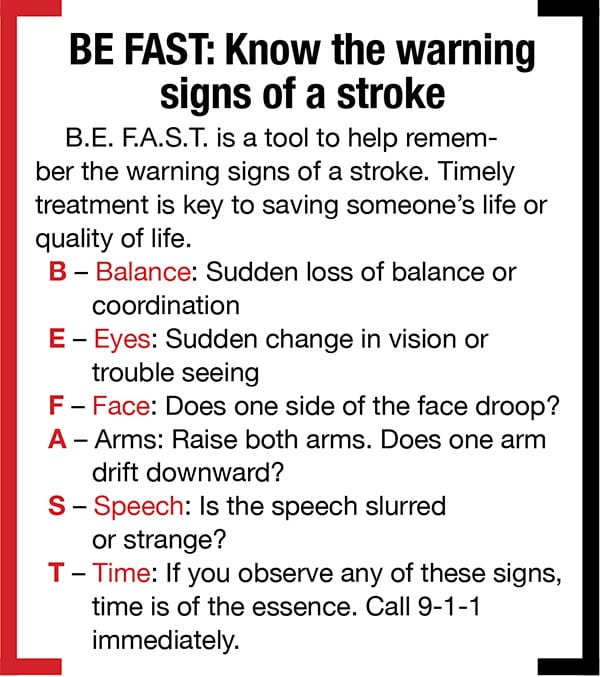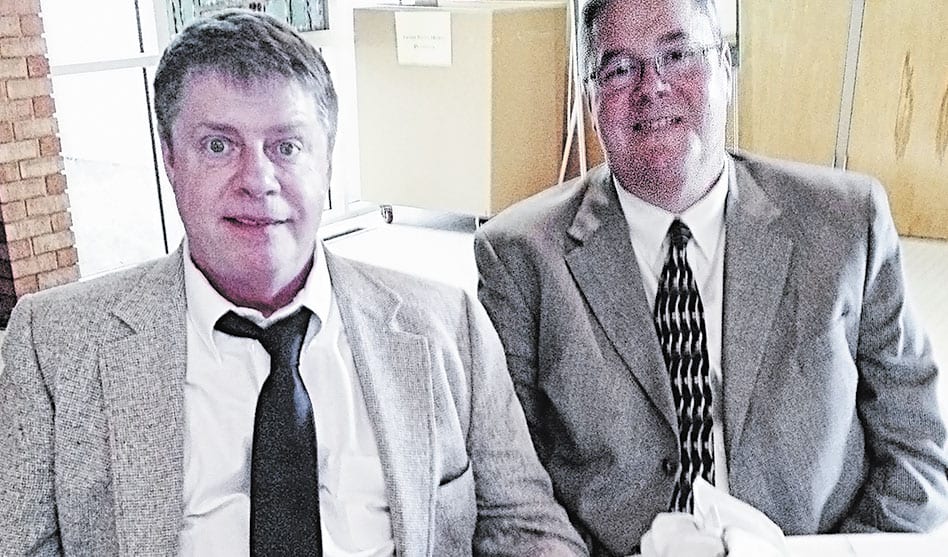Rett Evans, left, and Wynne Voorhees
Wynne Voorhees is a prime example of the importance of getting help quickly
DAVID TAFFET | Senior Staff Writer
taffet@dallasvoice.com
When Rett Evans told his partner, Wynne Voorhees, he was having a terrible sinus headache, Voorhees responded, “It must be catching. I’m getting one now.”
Voorhees went into the master closet then to change into his pajamas. He closed the door behind — and fell.
Evans had already fallen asleep. It was about 2 a.m. when he woke up and realized Voorhees wasn’t in bed. Evans got up, saw the closet light was on and realized Voorhees was inside. But he couldn’t open the door.
“He tried to get me to move so he could open the door,” Voorhees said. “He said I was slurring.”
In addition to slurring, Evans said, Voorhees’ left hand was clenched, and his face was drooping. He was unable to move.
Voorhees told his partner he had no idea what was going on and didn’t understand why he couldn’t move. Evans told Voorhees he was going to call 911, but Voorhees protested. “Don’t do that,” Voorhees said. “It’s not that bad.”
But Evans called anyway, and Dallas Fire and Rescue arrived within minutes. They were able to get the closet door open, but it took six people to get Voorhees downstairs. They rushed him to nearby Clements Hospital.
Emergency Room personnel quickly realized that Voorhees had had a stroke. So they had DFR transfer him down the street to Zale Lipshy, where a specialist on duty saved his life.
Being aware
May is National Stroke Awareness Month. Someone in the U.S. has a stroke every 40 seconds, and every four minutes, someone dies from a stroke.
Dr. Robin Novakovic, the specialist who treated Voorhees, said immediate response is vital. “The sooner we can intervene, the better the outcome,” she said.
 Voorhees said he thought if the stroke happened more than a couple of hours earlier, there was no way to treat it, that the damage was done. But he learned that recent studies show treatment up to 24 hours after the incident can have positive results.
Voorhees said he thought if the stroke happened more than a couple of hours earlier, there was no way to treat it, that the damage was done. But he learned that recent studies show treatment up to 24 hours after the incident can have positive results.
Still, sooner is always better than later.
Novakovic removed the stroke-causing clot in Voorhees’ brain by going in through the femoral artery in his groin. “She had to go in twice to get all of the [4-cm] clot,” Voorhees said.
Voorhees’ stroke affected the right side of his brain, which is not the side that affects language or cognitive thinking. “If it had gone to the other side, it would have taken out the language centers,” he said, making a full recovery a slow and arduous process.
But he was lucky: “When I woke up in Zale Lipshy’s neurological ICU, my speech was back and my body unclenched,” Voorhees said.
Voorhees recovered so quickly in fact, that he went back to work the next week — but only for a week — before going into rehab. The stroke affected his balance, so he began speech, occupational and physical therapy.
Part of his rehab included 45 minutes of daily exercise, something Voorhees said he had never done before.
The stroke occurred on March 21, and less than two months later, on May 18, Voorhees was discharged from rehab. He said he plans to return to work by next week.
“I’m probably 95 percent recovered,” Voorhees said. “I’m testing in the high normal range for someone my age.” He’s 61.
Now he has to prevent another stroke from happening. “If you don’t do anything about your life, you’re likely to have another,” he said.
Voorhees is exercising and looking for a gym. So far, he’s lost 25 pounds. He’s been diabetic since he was 30, but his blood sugar is now normal.
Watch for the signs
Novakovic said it is important to be aware of the warning signs of a stroke. Some people experience temporary blockages, she said, adding that
“Symptoms last for less than five minutes. It can be a warning.”
A third of people who have warning strokes will go on to have a more severe stroke within a year, the doctor said.
Among the symptoms are weakness on one side, slurred speech, vertigo and balance. Also, look for the face drooping on one side.
Novakovic said Voorhees could be treated beyond just the first few hours after his stroke because the blockage was in a large artery. But she warned, “Only a few people can be treated up to 24 hours later.”
Some strokes can be treated by an anti-platelet medication like aspirin, and some patients need a blood thinner like Coumadin.
Novakovic said stroke is the fifth leading cause of death in the U.S. But it is the leading cause of disability.
While anyone can have a stroke, some indicators that someone may be at higher risk include high blood pressure, diabetes, high cholesterol, poor diet, obesity, atrial fibrillation, smoking and illicit drug use.
“The best thing to do is get yearly physicals,” Novakovic urged.
She also encouraged people to eat healthy. That includes eating fresh fruit and vegetables daily and a diet of white meat and fish rather than red meats. Get 30 minutes of exercise a day, she said.
Strokes can affect all ages, and while some people have a genetic predisposition for having a stroke, Novakovic said, the threat increases when people reach their mid-40s to 50s. Nearly a quarter of all strokes occur in people under the age of 65, but the risk of stroke doubles each decade after the age of 55.
If you or someone near you has a stroke, Novakovic urged, “Get to the ER as fast as possible. Stroke has a sudden onset of symptoms. Call 911 if you suspect someone is having a stroke.”
She said to use EMS, which will not only get you there fast, but they’ll triage you faster. You’re more likely to get stroke treatment when transported by ambulance than if someone drives you to the ER.
For partners who aren’t married, Evans had some additional advice.
He said Voorhees was trying to communicate, but just wasn’t able to do it, so he had to approve the transfer to Zale Lipshy and sign papers for treatment.
“Get your paperwork done, so when you have to make decisions, they have to listen to you,” Evans said.












